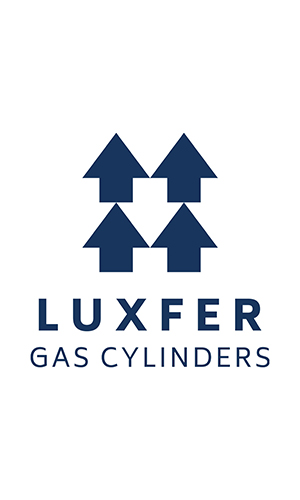US +1800 764 0366 | Europe & Middle East +44 (0)115 980 3800 | Asia-Pacific: +61 2 7227 5369
Paint removal and repainting of Luxfer all-metal and composite cylinders made from 6061 aluminum alloy (L6X®)

Preparation
All-metal Luxfer 6061 aluminum alloy (L6X®) cylinders1—To remove paint from an all-metal cylinder and prepare the surface for repainting, blast with plastic, glass or other soft media just long enough to remove most of the old paint. Do not blast with sand, steel, grit or aluminum oxide media, which are too abrasive. Heavy or improper blasting with hard or overly abrasive media removes metal as well as paint from the cylinder, which can thin the cylinder wall and make the cylinder unsafe to fill or use. Improper blasting also obliterates stamped markings and damages the outer surface of the cylinder.
Never use corrosive, caustic or acidic paint strippers or solvents to remove paint. Never use burning or torching techniques. Do not use knives or other sharp instruments to remove labels.
Once paint has been removed, use a neutral, mild, water-based detergent to wash the cylinder. Rinse the cylinder well and thoroughly dry it at a metal temperature not exceeding 160 degrees F (70 degrees C). Carefully inspect the cylinder surface for damage and corrosion in accordance with all applicable regulations. If the cylinder passes the inspection, it is ready for repainting.
Composite cylinders—Do not attempt to remove intact old paint from composite cylinders by blasting or any other means that may damage the cylinder exterior. Lightly rub the surface with fine-grit emery paper to prepare it for repainting. If the surface is dirty, clean it with a neutral, mild, water-based detergent, then rinse it well and dry it thoroughly.
Never use corrosive, caustic or acidic paint strippers or solvents to remove paint or to clean composite cylinders. Never use burning or torching techniques. Do not use knives or other sharp instruments to remove labels.
Once the outer surface of the cylinder is clean, inspect it for damage in accordance with all applicable regulations. If the cylinder passes the inspection, it is ready for repainting.
All cylinder types—Do not use the above preparatory processes on the internal surface and thread area of any Luxfer cylinder. Different processes (not covered by this document) should be used to clean threads and internal surfaces.
While preparing a cylinder exterior for painting, take care not to damage the valve connection area or cylinder threads. Do not allow any process materials (e.g., cleaning agents, blast media, grit, etc.) to contaminate the threads and inside of the cylinder.
Painting
All-metal Luxfer 6061 aluminum alloy (L6X®) cylinders—Do not use acidic or caustic paints that may damage the cylinder exterior. You may use any neutral, air-drying or aliphatic, water-based or solvent-based liquid paint that is compatible with aluminum. You may also use neutral, aluminum-compatible powder coatings as long as curing temperatures and exposure times do not exceed those recommended by Luxfer. Please note that different aluminum alloys have different maximum-temperature specifications; for example, for Luxfer 6061-alloy (L6X®) cylinders, the maximum metal temperature must not exceed 350ºF (175ºC). Exposure times at various temperatures vary according to alloy. Please contact Luxfer for time/temperature information about the particular cylinder and alloy that you intend to repaint using powder coatings. Cylinders subjected to temperatures and exposure times exceeding Luxfer recommendations or heated to unknown temperatures must pass hydrostatic tests before being filled or used.
Composite cylinders—Use flame-retardant, air-drying or aliphatic, water-based or solvent-based epoxy or polyurethane liquid paints on Luxfer composite cylinders. Do not heat cylinders to speed up curing or drying of paint. Do not use powder coatings or other coatings that must be heated or baked. Never expose composite cylinders to heat exceeding 180ºF (82ºC).
Do not paint over cylinder labels. Mask labels before painting and make sure that they remain legible. (Note: Color coding cylinders to identify gas contents or usage does not eliminate the regulatory requirement for legible, properly configured labels.)
All cylinder types—Do not allow paint to contaminate the threads, valve connection area or internal surface of any Luxfer cylinder.
1Luxfer markets its proprietary version of 6061 aluminum alloy under the registered trade name L6X
Posted by Luxfer